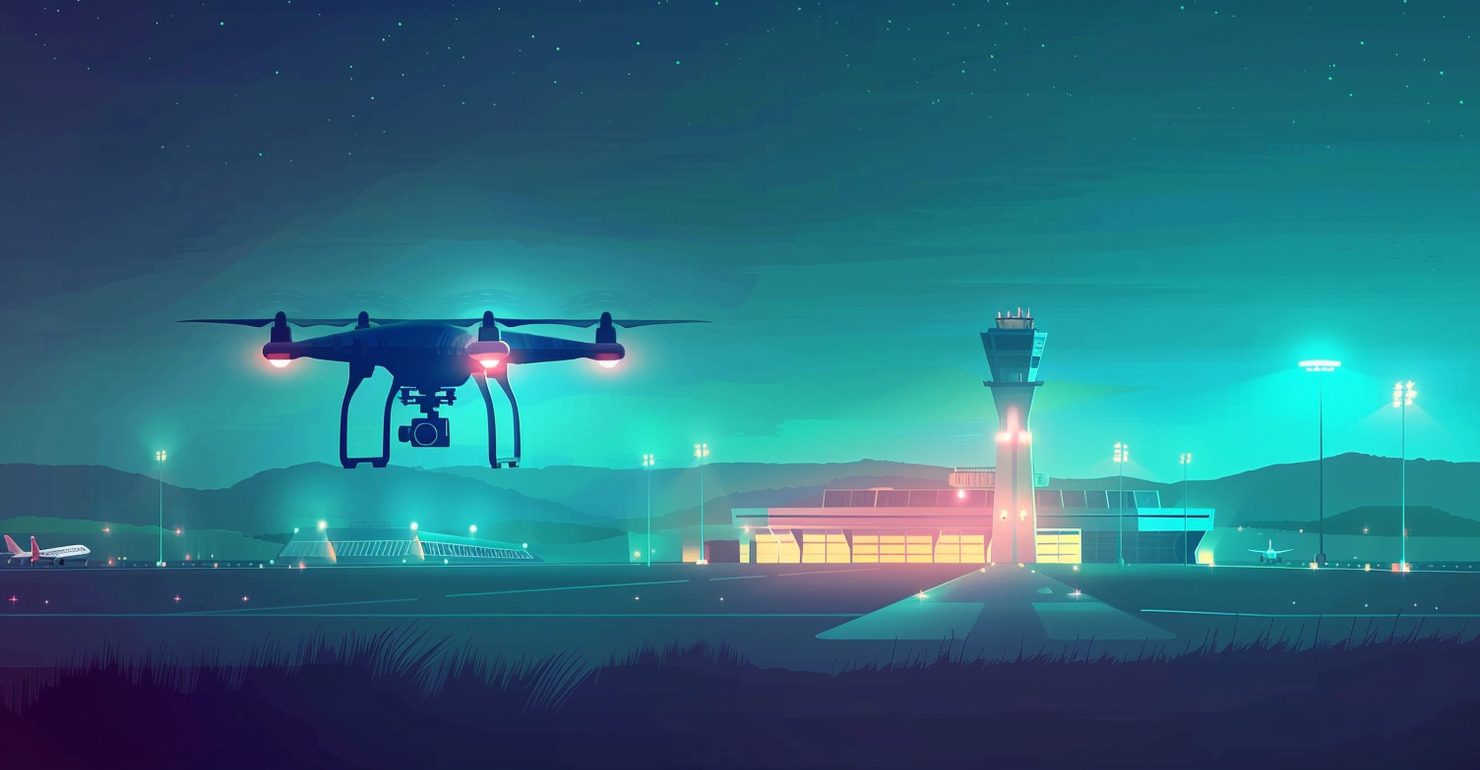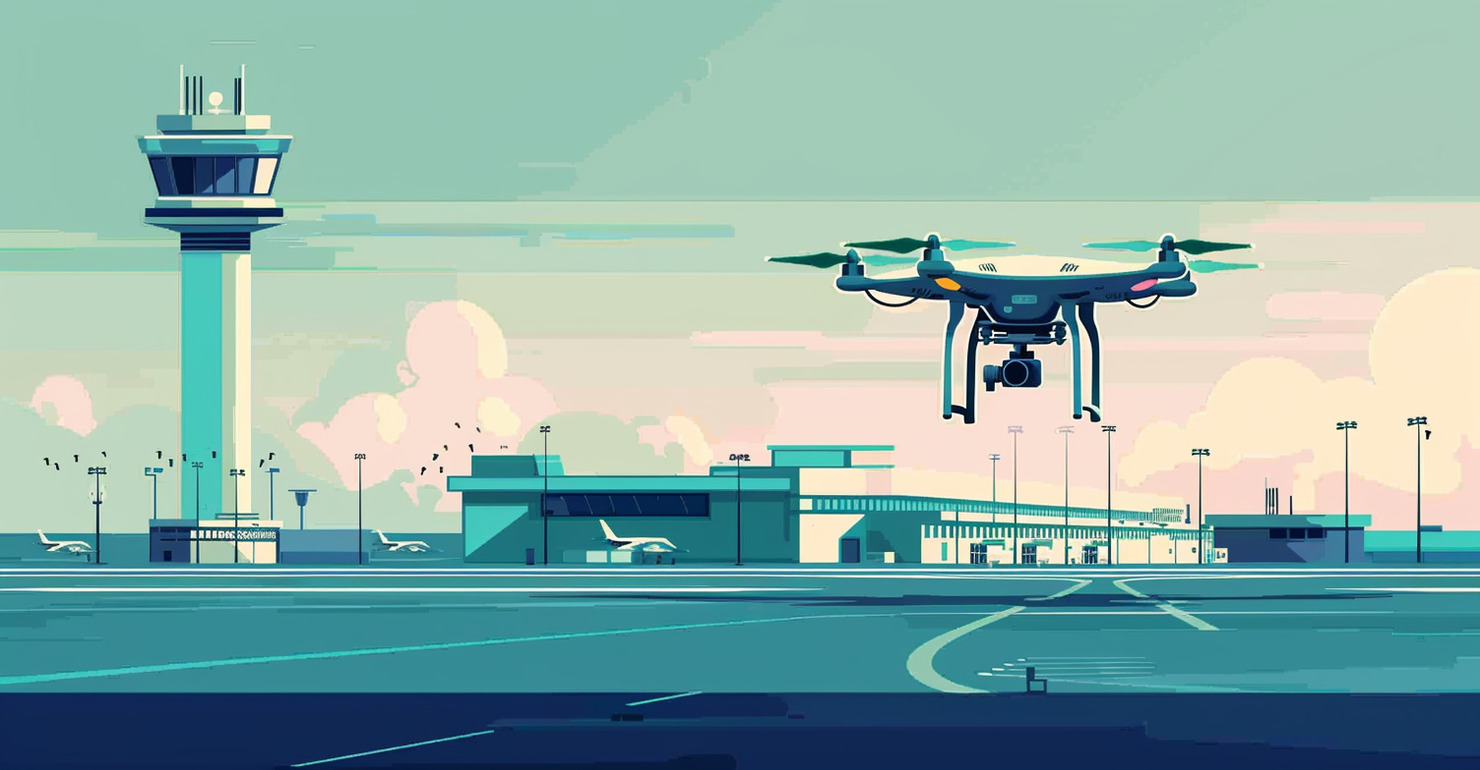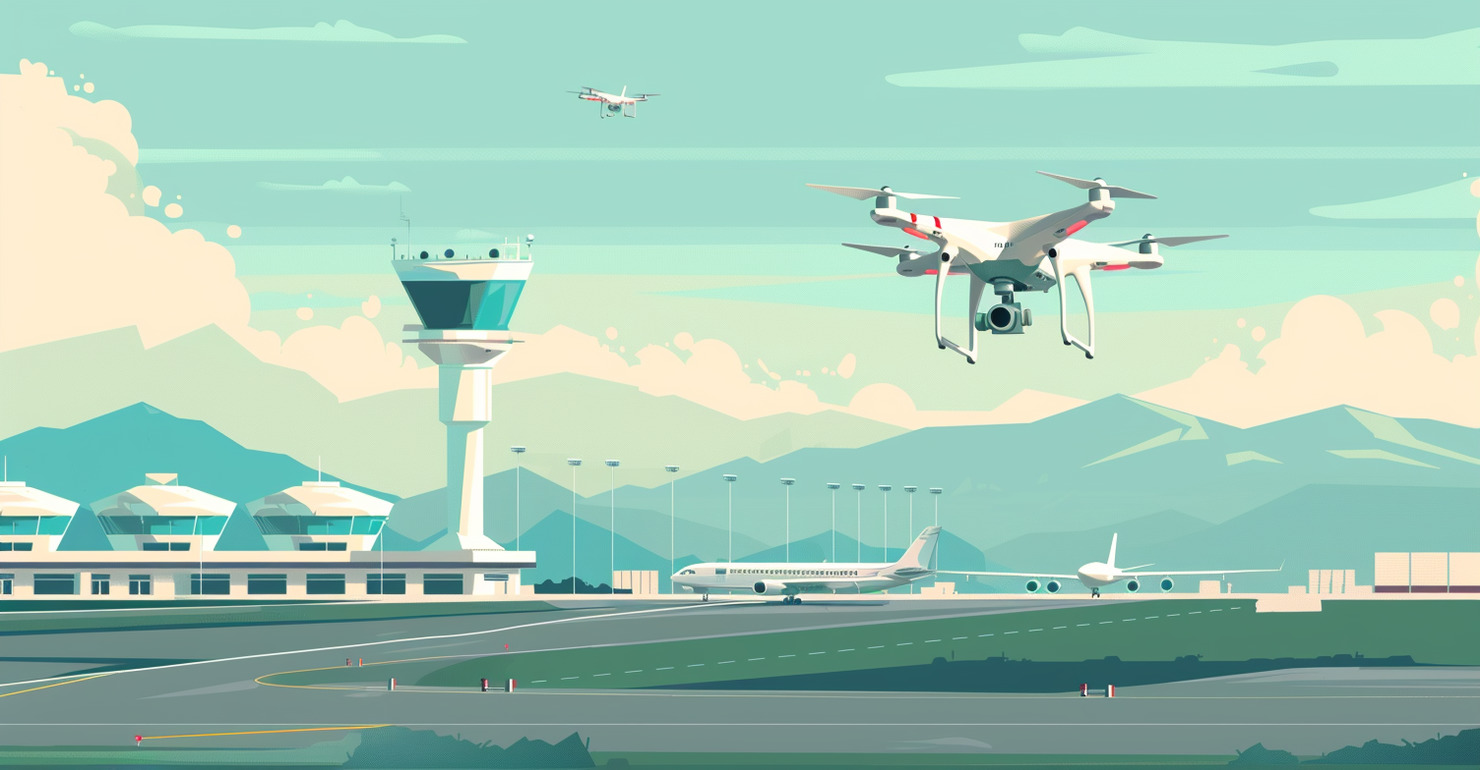
Enhancing Airport Security with Advanced Drone Surveillance Systems
Airport security is of utmost importance in today’s world, where the threat of terrorism and illegal activities remains a constant concern. Traditional security measures are no longer enough to address the evolving nature of these threats. As a result, airports are turning to advanced technologies such as drone surveillance systems to bolster their security protocols.
In this article, we will explore the role of drone surveillance systems in enhancing airport security. We will discuss the prohibited use of drones at airports, advancements in drone technology, and demonstrations of drone surveillance systems. Additionally, we will delve into the challenges and solutions associated with integrating these systems into existing infrastructure, as well as the regulatory and operational hurdles that need to be addressed.
Furthermore, we will examine case studies such as the Gatwick Airport closure and the London Heathrow Airport’s comprehensive drone detection system. We will also analyze the future directions of drone surveillance systems, including government support for drone technology and the importance of collaboration between stakeholders.
In conclusion, drone surveillance systems have the potential to revolutionize airport security by providing real-time monitoring and detection capabilities. As technology continues to evolve, these systems will become even more vital in ensuring the safety and security of airports worldwide.
Overview of the topic
Enhancing Airport Security with Advanced Drone Surveillance Systems
As airports face increasing security challenges, the incorporation of advanced technologies has become crucial. One such technology that is gaining prominence is drone surveillance systems. These systems provide airports with enhanced monitoring capabilities and the ability to detect and respond to potential security threats in real-time.
The use of drones at airports is strictly prohibited in most countries due to safety concerns. However, advancements in drone technology have led to the development of specialized systems and regulations for managing their safe use in airport environments.
Demonstrations of drone surveillance systems have showcased their effectiveness in enhancing perimeter security and providing situational awareness during incidents. These systems utilize advanced video analytics, high-resolution cameras, and integrated access control solutions to create safer airport environments.
Despite their potential benefits, the integration of drone surveillance systems into existing airport infrastructure poses challenges. Integration requires careful coordination with air traffic control procedures and the implementation of Unmanned Aircraft Systems Traffic Management (UTM) to ensure safe coexistence with manned aircraft.
Regulatory and operational challenges also need to be addressed, including privacy concerns, airspace management, and the training and certification of drone operators. Government support and collaboration between stakeholders are essential for establishing standardized regulations and guidelines for the use of drone surveillance systems in airports.
Case studies such as the Gatwick Airport closure highlight the importance of robust surveillance systems in mitigating the risks associated with rogue drones. London Heathrow Airport’s comprehensive drone detection system serves as a leading example of effective integration and utilization of these systems.
In conclusion, the adoption of advanced drone surveillance systems offers significant potential for enhancing airport security. These systems provide airports with advanced monitoring capabilities, improved situational awareness, and the ability to respond swiftly to security threats. However, addressing challenges related to integration, regulation, and operational procedures is vital for the successful implementation of these systems at airports.
Importance of airport security
The importance of airport security cannot be overstated, considering the potential risks and threats that airports face in today’s world. Airports serve as major transit hubs for millions of travelers, making them attractive targets for terrorism, smuggling, and other criminal activities.
Enhanced security measures are necessary to ensure the safety of passengers, airport staff, and critical infrastructure. The use of advanced drone surveillance systems plays a significant role in bolstering airport security. These systems provide airports with improved monitoring capabilities, rapid response to security incidents, and enhanced situational awareness.
By integrating advanced video analytics, high-resolution cameras, and access control solutions, drone surveillance systems offer real-time monitoring of the airport perimeter and critical areas. This enables early detection of potential threats, such as unauthorized access, suspicious activities, or rogue drones.
The prohibited use of drones at airports is a clear indication of the potential security risks they pose. Drone technology has advanced rapidly, and there have been cases of drones being used for nefarious purposes, including smuggling drugs or breaching secure airspace. Therefore, it is crucial to address these security challenges effectively.
Incorporating advanced drone surveillance systems into existing airport infrastructure requires careful planning and coordination with air traffic control procedures. Integration must ensure the safe coexistence of manned aircraft and drones, necessitating the implementation of Unmanned Aircraft Systems Traffic Management (UTM).
Regulatory and operational challenges also need to be addressed to ensure the effective use of drone surveillance systems. Privacy concerns, airspace management, and the training and certification of drone operators are some of the key aspects that require attention.
Through case studies like the Gatwick Airport closure and London Heathrow Airport’s comprehensive drone detection system, the importance of robust surveillance systems in mitigating security risks becomes evident. These systems serve as effective tools in countering unauthorized drone activities and enhancing overall airport security.
In conclusion, the importance of airport security cannot be underestimated. Advanced drone surveillance systems offer a proactive approach to addressing security threats by providing real-time monitoring, detection, and response capabilities. By integrating these systems into existing infrastructure and addressing the associated challenges, airports can significantly enhance their security measures and ensure the safety of passengers and personnel.
The Role of Drone Surveillance Systems in Enhancing Airport Security

Drone surveillance systems play a crucial role in enhancing airport security by providing advanced monitoring capabilities and real-time detection of potential threats. These systems utilize cutting-edge technologies such as video analytics, high-resolution cameras, and access control solutions to create safer environments for airports and their stakeholders.
By deploying drone surveillance systems, airports can proactively monitor the perimeter and critical areas, enabling early detection of unauthorized access or suspicious activities. The use of drones at airports is strictly prohibited due to safety concerns, but advancements in drone technology have led to specialized systems and regulations for safe drone operations in airport environments.
Demonstrations of drone surveillance systems have showcased their effectiveness in enhancing airport security. For example, tethered drone systems have been shown to enhance perimeter security, while utilizing drones during incidents has improved public safety in various scenarios, including pandemic response.
Despite the benefits provided by drone surveillance systems, there are challenges to their integration into existing airport infrastructure. This includes coordinating with air traffic control procedures, implementing Unmanned Aircraft Systems Traffic Management (UTM) for safe coexistence with manned aircraft, and addressing regulatory and operational considerations.
Case studies such as the TSA’s testing of drone detection technology at Los Angeles International Airport (LAX) and the Gatwick Airport closure highlight the importance of robust surveillance systems in countering security threats. Other airports, like London Heathrow, have implemented comprehensive drone detection systems for enhanced security.
In conclusion, drone surveillance systems have a pivotal role in enhancing airport security by providing advanced monitoring capabilities and real-time threat detection. Through their integration with existing infrastructure and collaboration between stakeholders, airports can ensure the safety and security of passengers, staff, and critical assets.
Prohibited use of drones at airports
The use of civil drones at airports is strictly prohibited in most countries due to the potential safety threats they pose. Flying drones over airports can disrupt aircraft operations and endanger the safety of passengers and infrastructure.
In response to these concerns, airport authorities and aviation regulatory bodies have implemented regulations and restrictions on drone operations near airports. These measures aim to prevent unauthorized drone flights and mitigate the risks associated with their presence in airport airspace.
The Gatwick Airport closure in 2018 served as a significant wake-up call regarding the potential consequences of rogue drone activity. Following this incident, many airports have started investing in advanced surveillance equipment specifically designed to detect and track drones. London Heathrow Airport has emerged as a leader in this field, deploying a comprehensive drone detection system.
Airport surveillance systems have evolved to incorporate high-resolution radars, electro-optical cameras, radio direction finders, and other specialized equipment to monitor and identify any unusual objects in the airspace. These innovative systems not only improve security by protecting airports from unauthorized drones but also facilitate the safe and controlled use of drones for beneficial purposes.
Looking ahead, advancements in technology and the development of regulations will continue to address the challenges associated with drones at airports. It is crucial for airport operators, regulatory authorities, and industry stakeholders to collaborate and implement effective measures that ensure the safe and secure operation of airports while taking advantage of the potential benefits that drones can offer.
Advancements in drone technology
The field of drone technology has experienced rapid advancements, fueling its potential in enhancing airport security measures. These advancements have led to the development of more sophisticated and capable drone surveillance systems.
One area of advancement is in the development of advanced video analytics. Drones equipped with AI-powered software can analyze real-time video feeds, allowing for the identification of suspicious activities or potential security threats. These analytics enable airports to quickly respond to incidents and enhance situational awareness.
Another significant advancement is the improvement of high-resolution cameras on drones. These cameras provide detailed imagery, allowing for better identification and tracking of individuals or objects within the airport premises. Higher resolution imagery enhances the effectiveness of surveillance and monitoring efforts.
Drone manufacturers are also focusing on improving flight capabilities such as longer endurance, increased range, and higher payload capacity. These improvements allow drones to cover larger areas and carry more advanced sensors, further enhancing their surveillance capabilities.
In addition to hardware advancements, advancements in software and communication technologies have also contributed to the growth of drone surveillance systems. Integration with existing security systems, information sharing platforms, and automation technologies enables better coordination and response to potential security threats.
The integration of drone surveillance systems with other technologies, such as access control solutions and perimeter security systems, has further enhanced the capabilities of these systems. By integrating and harnessing the power of multiple technologies, airports can create more comprehensive and layered security systems.
Overall, advancements in drone technology continue to drive the evolution of drone surveillance systems, making them increasingly vital in enhancing airport security. These advancements improve detection capabilities, increase operational efficiency, and provide valuable insights to security personnel, ensuring safer and more secure airport environments.
Demonstrations of drone surveillance systems
Demonstrations of drone surveillance systems have proven their effectiveness in enhancing airport security measures. These demonstrations showcase the capabilities and potential of these advanced systems in real-world scenarios.
For example, a demonstration conducted in Malaysia highlighted how tethered drone systems can enhance perimeter security at airports. These systems provide continuous aerial surveillance, allowing for early detection of intrusions and suspicious activities in the airport vicinity.
Furthermore, the Transportation Security Administration (TSA) has initiated testing of technology designed to detect, track, and identify drones entering restricted airspace around Los Angeles International Airport (LAX). This demonstration aims to evaluate the effectiveness of drone detection technology in safeguarding airport security.
The integration of video analytics and access control solutions in drone surveillance systems has also been demonstrated. By utilizing AI-powered software, these systems can analyze real-time video feeds and identify potential security threats or unauthorized access, enabling proactive response and enhancing overall airport security.
The Gatwick Airport closure in 2018 served as a notable incident that led to the exploration and implementation of robust surveillance systems to combat rogue drone activity. This incident emphasized the need for comprehensive drone detection systems, such as the one deployed at London Heathrow Airport.
Drone surveillance systems have also proven valuable in other industries, such as border security. Unmanned aerial vehicles equipped with high-resolution cameras and advanced sensors offer a birds-eye view of vast areas, aiding in the detection and identification of potential threats along borders.
These demonstrations highlight how drone surveillance systems are at the forefront of airport security advancements. By leveraging advanced technology and integrated surveillance capabilities, airports can ensure safer environments for passengers, staff, and critical infrastructure.
Challenges and Solutions
Enhancing airport security with advanced drone surveillance systems comes with its own set of challenges that need to be addressed. These challenges include security threats posed by drones, integration of drone surveillance systems with existing infrastructure, and regulatory and operational hurdles.
One of the primary challenges is the security threats posed by drones themselves. Rogue drones can disrupt airport operations, endangering the safety of aircraft, passengers, and critical infrastructure. It is crucial to develop effective countermeasures and detection systems to mitigate these threats.
The integration of drone surveillance systems with existing airport infrastructure presents another challenge. Coordination with air traffic control procedures, implementation of Unmanned Aircraft Systems Traffic Management (UTM), and ensuring the safe coexistence of manned aircraft and drones require careful planning and collaboration.
Regulatory and operational challenges also need to be addressed. Privacy concerns, airspace management, and the training and certification of drone operators are key considerations. Establishing standardized regulations and guidelines for the use of drone surveillance systems at airports is essential for their effective and safe operation.
To overcome these challenges, innovative solutions are being implemented. This includes the deployment of advanced surveillance equipment such as short-range high-resolution radars, electro-optical cameras, and radio direction finders. Comprehensive drone detection systems, like the one deployed at London Heathrow Airport, are crucial in mitigating security risks.
In addition, collaboration between airport operators, regulatory authorities, technology providers, and other stakeholders is vital in addressing these challenges. Sharing best practices, lessons learned, and implementing robust security protocols will ensure the successful integration and operation of drone surveillance systems in enhancing airport security.
In conclusion, while there are challenges associated with enhancing airport security with advanced drone surveillance systems, innovative solutions and collaborative efforts can overcome these hurdles. By addressing security threats, integrating systems with existing infrastructure, and establishing effective regulations, airports can leverage the potential of drone surveillance systems for enhanced security measures.
Security threats posed by drones
The rise of drones has brought about security concerns at airports due to their potential misuse. Rogue drones can disrupt airport operations, pose risks to aircraft, and compromise the safety of passengers and critical infrastructure.
The Gatwick Airport incident in 2018, where the airport was shut down due to rogue drone activity, highlighted the seriousness of these security threats. This incident prompted airports to invest in advanced surveillance equipment such as short-range high-resolution radars, electro-optical cameras, and radio direction finders to detect and monitor unauthorized drones.
To counter the security threats posed by drones, airports have deployed comprehensive drone detection systems. London Heathrow Airport, for example, implemented one of the most extensive drone detection systems, integrating advanced technologies like holographic radars to monitor and identify drone activity.
Addressing drone security threats also involves the development of regulations and procedures specific to managing these new airspace users. Traditional air traffic control systems and surveillance techniques are not designed to track smaller, slower drones effectively. The lack of suitable equipment and regulation requires innovative approaches and collaboration with industry stakeholders to ensure airspace safety around airports.
By deploying counter-drone systems and innovative surveillance measures, airports can protect against unauthorized and rogue drones while also allowing the controlled and safe use of drones within airport operations. These measures aim to ensure the security, efficiency, and capacity of airports while mitigating the potential negative impacts of drone activity.
Integration of drone surveillance systems with existing infrastructure
The integration of drone surveillance systems with existing airport infrastructure presents both opportunities and challenges. To effectively utilize drone surveillance systems for enhancing airport security, seamless integration is crucial.
One of the primary challenges is integrating drone operations with air traffic control procedures. This requires coordination to ensure safe coexistence between manned aircraft and drones in shared airspace. The implementation of Unmanned Aircraft Systems Traffic Management (UTM) systems is necessary to manage the flow of drone traffic and prevent any disruptions to airport operations.
Another challenge is the physical integration of drone surveillance systems with existing security infrastructure. This includes incorporating high-resolution cameras, advanced video analytics, and other sensor technologies into the existing surveillance network. It also involves connecting these systems to centralized monitoring and control systems for effective operation and response.
Data integration is another aspect to consider. Efficiently integrating the data collected by drone surveillance systems with existing airport security systems, such as access control and video management systems, enables a more comprehensive and cohesive security approach. This integration allows for real-time monitoring, detection, and response to potential security threats.
Despite these challenges, the integration of drone surveillance systems with existing infrastructure offers significant benefits. It provides enhanced situational awareness, rapid response capabilities, and improved perimeter security. It allows for proactive monitoring of critical areas, identification of unauthorized access, and detection of suspicious activities.
Successful integration requires collaboration between airport operators, regulatory authorities, technology providers, and other stakeholders. By working together, they can ensure that the integration process addresses technical, operational, and regulatory considerations. This collaboration also facilitates the development of standardized guidelines and best practices for the effective and secure integration of drone surveillance systems with existing airport infrastructure.
Regulatory and operational challenges
Enhancing airport security with advanced drone surveillance systems presents regulatory and operational challenges that need to be addressed to ensure their effective implementation.
From a regulatory standpoint, there is a need to establish clear guidelines and regulations for the use of drones in airport environments. This includes addressing airspace management, privacy concerns, and the certification and training of drone operators to ensure compliance with safety and security standards.
Operational challenges include integrating drone surveillance systems seamlessly into existing airport infrastructure. This requires coordination with air traffic control procedures to ensure the safe coexistence of manned aircraft and drones. Implementing Unmanned Aircraft Systems Traffic Management (UTM) is crucial for managing the flow of drone traffic.
Another operational consideration is the integration of drone surveillance data with existing security systems. Efforts should be made to harmonize data transfer protocols and ensure smooth interoperability between drone surveillance systems and other security technologies such as video management systems and access control solutions.
Addressing these challenges requires collaboration between airport authorities, regulatory bodies, technology providers, and other stakeholders. Sharing best practices and lessons learned can facilitate the development of standardized procedures and guidelines for the integration of drone surveillance systems into existing airport operations.
Investing in research and development to further enhance the capabilities of drone surveillance systems and address operational challenges is also crucial. This includes advancements in video analytics, sensor technologies, and communication systems to improve the efficiency and effectiveness of these systems in detecting and responding to potential security threats.
By overcoming regulatory and operational challenges, airports can unlock the full potential of drone surveillance systems in enhancing airport security and create safer environments for passengers, staff, and infrastructure.
Case Studies

Enhancing Airport Security with Advanced Drone Surveillance Systems involves learning from real-world case studies that demonstrate the effectiveness of these systems. Two notable cases are the Gatwick Airport closure and the deployment of comprehensive drone detection systems at London Heathrow Airport.
In 2018, the closure of Gatwick Airport for over 24 hours due to rogue drone activity highlighted the urgent need for robust surveillance measures. Following this incident, airports worldwide began investing in innovative equipment such as short-range high-resolution radars, electro-optical cameras, and radio direction finders to detect and monitor unauthorized drones.
London Heathrow Airport, one of the leaders in drone detection systems, has implemented a comprehensive system that includes advanced holographic radars developed by Aveillant, in collaboration with Operational Solutions Limited (OSL). This solution combines multiple technologies to accurately detect and track drones in real-time within the airport airspace.
These case studies demonstrate the effectiveness of drone surveillance systems in countering security threats and safeguarding airports. By incorporating advanced surveillance equipment and innovative detection technologies, airports can enhance their security measures and ensure the safe operation of flights, protecting both passengers and critical infrastructure.
Learning from these cases, airports worldwide are recognizing the importance of investing in robust counter-drone measures to protect against unauthorized and rogue drones. These advanced surveillance systems not only provide security but also enable controlled and safe use of drones within airport operations when necessary.
Gatwick Airport closure
The Gatwick Airport closure in 2018 demonstrated the urgent need for robust surveillance measures to counter rogue drone activity. Gatwick Airport was shut down for over 24 hours due to unauthorized drone presence, resulting in significant disruptions to flights and passenger inconvenience.
In response to this incident, many airports have invested in innovative surveillance equipment specifically designed to detect and monitor drones. Short-range high-resolution radars, high-definition electro-optical cameras, and radio direction finders are examples of the equipment now being employed to detect unusual objects in the airspace surrounding airports.
London Heathrow Airport, a leader in the field, has implemented one of the most comprehensive drone detection systems among airports. The system incorporates advanced holographic radars from Aveillant, in collaboration with Operational Solutions Limited (OSL), to accurately detect and track drones in real-time.
These counter-drone surveillance systems not only protect against unauthorized or rogue drones but also enable the controlled use of drones within airport operations. It has become evident that these innovative airport surveillance systems can help ensure the safe integration of both good and bad drones into airport environments.
Overall, the Gatwick Airport closure served as a catalyst for enhancing airport security through the deployment of cutting-edge surveillance technologies capable of detecting and mitigating potential threats posed by drones.
London Heathrow Airport
London Heathrow Airport, a leader in drone detection systems, has implemented one of the most comprehensive solutions among airports. This includes the deployment of advanced holographic radars developed by Aveillant in partnership with Operational Solutions Limited (OSL).
The drone detection system at London Heathrow Airport combines multiple technologies to accurately detect and track drones in real-time within the airport airspace. These advanced holographic radars provide enhanced detection capabilities, enabling the airport to identify potential security threats posed by unauthorized drones.
By incorporating such comprehensive drone detection systems, London Heathrow Airport has been able to enhance its overall security measures. These systems play a crucial role in countering unauthorized drone activities and ensuring the safe operation of flights and protection of critical infrastructure.
London Heathrow Airport showcases how airports can leverage advanced drone surveillance technologies to safeguard against security threats posed by drones effectively. The deployment of these systems demonstrates the airport’s commitment to adopting innovative solutions for enhancing airport security.
As other airports face similar challenges, they can draw inspiration from London Heathrow Airport’s proactive approach in implementing comprehensive drone detection systems to protect their operations and maintain a high level of security.
Future Directions
The future of enhancing airport security with advanced drone surveillance systems shows promising advancements and developments. As technology continues to evolve, several important directions are shaping the future:
- AI-Powered Systems: Integration of artificial intelligence (AI) algorithms will further enhance the capabilities of drone surveillance systems. AI-based video analytics will enable more accurate detection of security threats and provide real-time insights for effective decision-making.
- Enhanced Detection Technologies: Continued research and innovation in detection technologies such as radar, optical sensors, and RF scanners will improve the ability to detect and track drones, enabling quicker response times and ensuring a higher level of airport security.
- Improved Communication and Integration: Enhanced communication protocols and seamless integration with existing airport security systems will improve the overall effectiveness of drone surveillance systems. This includes better coordination with air traffic control, integration with video management systems, and compatibility with access control solutions.
- Regulatory Framework: Governments and regulatory bodies will play a crucial role in establishing clear and standardized regulations for the operation of drones at airports. These regulations will address airspace management, privacy concerns, and licensing requirements to ensure safe and secure drone operations.
- Collaboration and Partnerships: Collaboration between airport operators, technology providers, regulatory authorities, and other stakeholders will be essential to share best practices and knowledge. Establishing strong partnerships will lead to collaborative efforts in addressing challenges and implementing innovative solutions to enhance airport security.
By focusing on these future directions, airports can continue to leverage advanced drone surveillance systems and stay ahead of emerging security threats. Through ongoing research and collaboration, airports can create safer environments and ensure efficient and secure operations, ultimately providing a seamless experience for passengers and staff.
Government support for drone technology
Government support is crucial for the advancement and integration of drone technology in enhancing airport security. Various government initiatives and programs have been established to promote the adoption of advanced drone surveillance systems.
For instance, the Future Flight challenge in the UK is a government-supported program that provides funding for the development of new aviation systems, including high-intensity drone operations. This initiative aims to support the research and development of innovative drone technologies for various applications, including airport security.
Government support is not limited to financial aid but also involves the establishment of regulations and guidelines that ensure the safe and responsible use of drones. These regulations address airspace management, licensing requirements for drone operators, and privacy concerns to protect the public and maintain the integrity of airport operations.
Moreover, governments collaborate with industry stakeholders to foster innovation and drive the development of drone technology. This collaboration creates opportunities for partnerships between drone manufacturers, technology providers, and airports, leading to the integration of advanced drone surveillance systems into existing infrastructure.
By providing the necessary support, governments play a crucial role in facilitating the advancement and integration of drone surveillance systems, ultimately enhancing airport security measures and ensuring the safety of passengers, staff, and critical infrastructure.
Collaboration between stakeholders
Collaboration between stakeholders is essential for the successful implementation of advanced drone surveillance systems and enhancing airport security.
Airport operators, government agencies, technology providers, and industry organizations must work together to share knowledge, best practices, and resources. This collaboration allows for a comprehensive approach to address security challenges and develop effective solutions.
Industry organizations and associations play a vital role in facilitating collaboration by providing forums for discussions, organizing conferences, and promoting information exchange. These platforms enable stakeholders to share experiences, insights, and lessons learned.
Government agencies can encourage collaboration by creating frameworks for partnerships and supporting innovative research and development initiatives. They can also establish regulatory guidelines that facilitate the integration of drone surveillance systems into existing airport infrastructure.
Technology providers play a crucial role in collaborating with airport operators and other stakeholders to develop customized solutions that meet specific security needs. By understanding the requirements and challenges faced by airports, technology providers can tailor their offerings to enhance airport security effectively.
Collaboration between stakeholders also extends to sharing data and intelligence. By integrating data from various sources such as drone detection systems, access control solutions, and video surveillance, stakeholders can gain a more comprehensive and real-time understanding of the security landscape.
Collective efforts and collaboration between stakeholders will drive continuous improvement in drone surveillance systems and ensure the highest level of security in airports. By working together, they can stay ahead of emerging threats, adapt to changing technologies, and create safer and more secure airport environments.
Conclusion
Enhancing airport security with advanced drone surveillance systems is a crucial step towards ensuring the safety and protection of airports, passengers, and critical infrastructure. The deployment of cutting-edge surveillance technologies, such as high-resolution radars, electro-optical cameras, and drone detection systems, has proven to be effective in countering security threats.
Government support and collaboration between stakeholders are key drivers in the development and integration of these systems. Governments provide financial aid, establish regulations, and foster partnerships to promote the safe and responsible use of drones at airports.
The future of drone surveillance systems holds exciting possibilities, including advancements in AI-powered systems, enhanced detection technologies, improved integration with existing infrastructure, and standardized regulatory frameworks.
Case studies, such as the Gatwick Airport closure and the comprehensive drone detection system at London Heathrow Airport, demonstrate the effectiveness of these systems in enhancing airport security and mitigating risks associated with rogue drones.
With continued collaboration, innovation, and regulatory support, airports can leverage advanced drone surveillance systems to create safer environments, streamline operations, and stay ahead of emerging security challenges.
Moving forward, the implementation of these advanced surveillance systems will play a vital role in protecting airports, maintaining efficient operations, and ensuring the safety and security of passengers and staff.
Summary of key points
Enhancing airport security with advanced drone surveillance systems involves:
- Deploying cutting-edge surveillance technologies like high-resolution radars and electro-optical cameras.
- Implementing comprehensive drone detection systems, such as those at London Heathrow Airport.
- Prohibiting the use of drones at airports due to safety concerns and security risks.
- Conducting demonstrations to showcase the capabilities of drone surveillance systems in enhancing airport security.
- Testing new technologies designed to detect, track, and identify drones entering restricted airspace.
- Addressing security threats posed by drones through advanced surveillance measures.
- Integrating drone surveillance systems with existing airport infrastructure, including air traffic control procedures and video management systems.
- Overcoming regulatory and operational challenges through collaboration between stakeholders.
- Gaining government support for the development and integration of drone technology in enhancing airport security measures.
- Looking ahead to future advancements, such as AI-powered systems and enhanced detection technologies.
- Fostering collaboration between stakeholders to share knowledge, resources, and best practices.
By addressing these key points, airports can create safer, more secure environments while harnessing the benefits and potential of advanced drone surveillance systems.
The future of drone surveillance systems
The future of drone surveillance systems is filled with opportunities and advancements. As technology continues to evolve, several key areas will shape the future:
- Improvements in detection and tracking: Advancements in radar, optical sensors, and other detection technologies will enhance the accuracy and range of drone detection systems.
- Artificial intelligence integration: AI-powered systems will play a significant role in analyzing data collected by drone surveillance systems, enabling real-time threat detection and response.
- Improved communication and collaboration: Enhanced coordination between various stakeholders, including airports, regulatory authorities, and technology providers, will lead to the development of standardized protocols and guidelines.
- Regulatory frameworks: Governments around the world will establish clear regulations to govern the safe and secure operation of drones in airport environments.
- Integration with existing infrastructure: Seamless integration of drone surveillance systems with existing airport infrastructure, such as air traffic control and security systems, will enable efficient operations and response capabilities.
- Advanced analytics and data management: Utilizing advanced analytics and data management techniques will improve the ability of drone surveillance systems to analyze, interpret, and leverage collected data.
By focusing on these future directions, drone surveillance systems will continue to enhance airport security measures. The seamless integration of these systems, along with advancements in technology and collaborative efforts between stakeholders, will create safer airport environments and ensure the safety and well-being of passengers, staff, and critical infrastructure.



